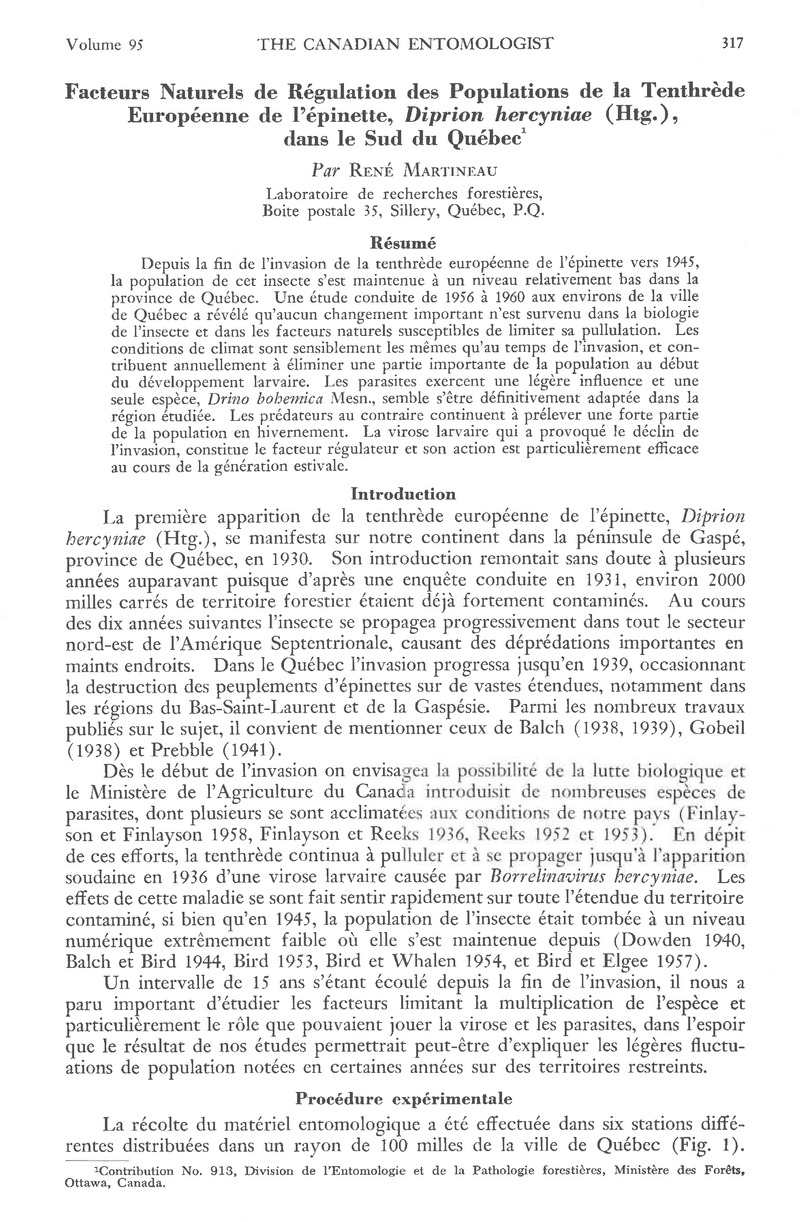Article contents
Facteurs Naturels de Régulation des Populations de la Tenthrède Européenne de l’épinette, Diprion hercyniae (Htg.), dans le Sud du Québec1
Published online by Cambridge University Press: 31 May 2012
Abstract
An abstract is not available for this content so a preview has been provided. Please use the Get access link above for information on how to access this content.

- Type
- Articles
- Information
- Copyright
- Copyright © Entomological Society of Canada 1963
References
Références
Balch, R. E. 1938. Estimation of spruce sawfly hazard and need of salvage. Can. Dept. Agr. Div. Entomol. and Can. Pulp and Paper Assoc. Woodlands Section. Joint Publ.Google Scholar
Balch, R. E. 1939. The outbreak of the European spruce sawfly in Canada and some important features of its bionomics. J. Econ. Ent., 32: 412–418.CrossRefGoogle Scholar
Balch, R. E., and Bird, F. T.. 1944. A disease of the European spruce sawfly, Gilpinia hercyniae (Htg.), and its place in natural control. Sci. Agric. 25: 65–80.Google Scholar
Bird, F. T. 1953. The effect of metamorphosis on the multiplication of an insect virus. Can. J. Zool. 31: 300–303.Google Scholar
Bird, F. T., and Whalen, M. M.. 1954. Stages in the development of two insect viruses. Can. J. Microbiol. 1: 170–174.Google Scholar
Bird, F. T., and Elgee, D. E.. 1957. A virus disease and introduced parasites as factors controlling the European spruce sawfly, Diprion hercyniae (Htg.) in central New Brunswick. Can. Ent. 89: 371–378.Google Scholar
Dowden, P. B. 1940. Larval disease prevalent in heavy infestations of the European spruce sawfly in southern New Hampshire and Vermont. J. Forestry 38: 970–972.Google Scholar
Finlayson, L. R., and Finlayson, T.. 1958. Notes on parasites of Diprionidae in Europe and Japan and their establishment in Canada on D. hercyniae (Htg.) (Hym.: Diprionidae). Can. Ent. 90: 557–563.CrossRefGoogle Scholar
Finlayson, L. R., and Reeks, W. A.. 1936. Notes on introduction of Diprion parasites to Canada. Can. Ent. 68: 160–166.CrossRefGoogle Scholar
Gobeil, A. R. 1938. Dommages causés aux forêts de la Gaspésie par les insectes. Ministère des Terres et Forêts, Québec. Service d'Entomologie, Bull. 2: 1–22.Google Scholar
Lambert, R. 1940. Les insectes forestiers du Québec en 1940. Ministère des Terres et Forêts, Québec. Service d'Entomologie. Contribution No. 10: 1–38.Google Scholar
Martineau, R. 1943. Population studies of the European spruce sawfly, Gilpinia hercyniae Htg. in Quebec. For. Chron. 19: 87–107.Google Scholar
Morris, R. F. 1951. The larval elaterid of eastern spruce forests and their rôle in the natural control of Gilpinia hercyniae Htg. (Hym.: Diprionidae). Can. Ent. 83: 133–147.CrossRefGoogle Scholar
Morris, R. F. 1959. Single factor analysis in population dynamics. Ecology 40: 580–588.CrossRefGoogle Scholar
Prebble, M. L. 1941. The diapause and related phenomena in Gilpinia polytoma (Htg.) Can. J. Research 19: 295–454.Google Scholar
Reeks, W. A. 1952. Establishment of Exenterus spp. (Hym.: Ichneumonidae), parasites of the European spruce sawfly, near points of introduction. Can. Ent. 84: 76–86.CrossRefGoogle Scholar
Reeks, W. A. 1953. The establishment of introduced parasites of the European spruce sawfly Diprion hercyniae Htg. (Hym.: Diprionidae) in the Maritime Provinces. Can. J. Agric. Sci. 33: 405–429.Google Scholar
- 1
- Cited by




